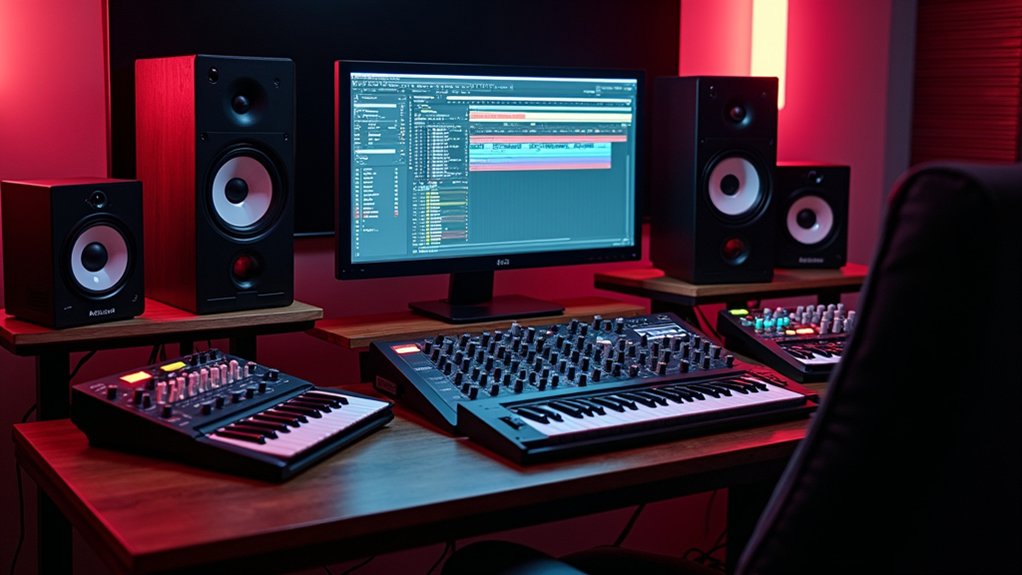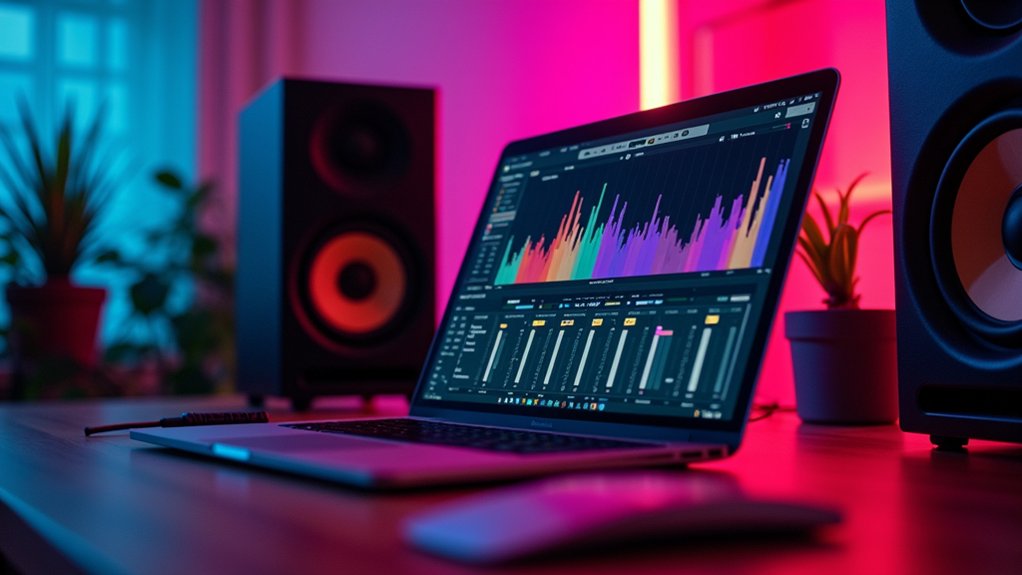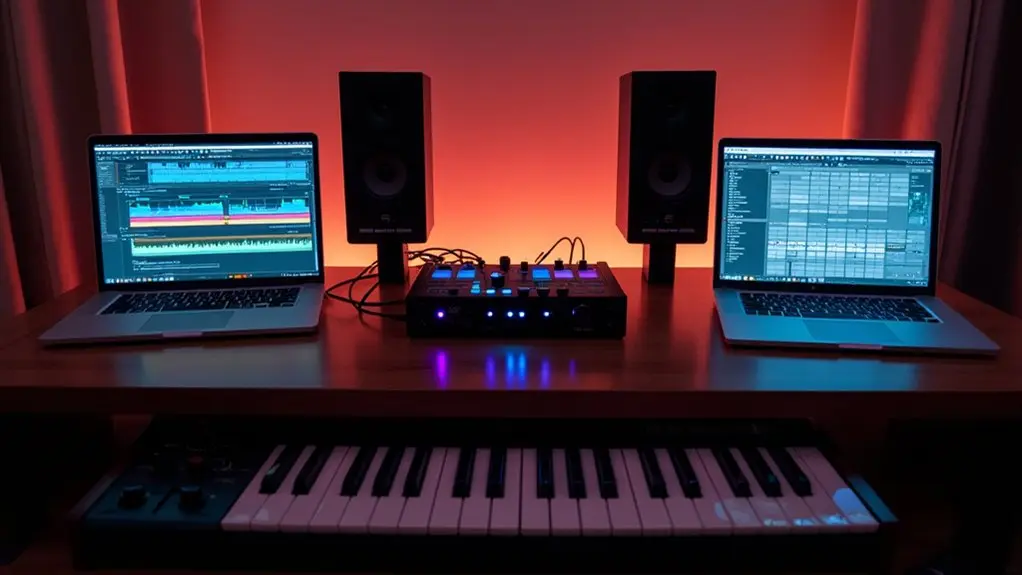Ableton’s Arpeggiator uses parameters like Steps, Gate, and Style to create melodic patterns by automatically triggering notes in sequence. Users can define octave range, note articulation, and direction for rhythmic precision. Effective arpeggiation involves selecting polyphonic, staccato, or rounded synth sounds and aligning the arpeggio rhythmically with bass lines. Applying filters, automation, or effects refines tonal qualities and spatial depth. Exploring MIDI FX racks and layering techniques can further enhance complexity and expressiveness beyond these basics.
Key Takeaways
- The Ableton Arpeggiator transforms held chords into rhythmic note sequences using customizable patterns and directions.
- Key parameters like Steps, Gate, Groove, and Style control octave range, note length, swing, and melodic contour.
- Polyphonic synths and staccato sounds work best to maintain clarity and definition in arpeggiated patterns.
- Layering arpeggiators, automating filters, and adding effects like delay or reverb enhance depth and movement.
- Synchronize arpeggios with bass lines by matching key, rhythm, and adjusting volume for balanced, musical results.
Understanding Arpeggiator Parameters
Mastery of Ableton’s Arpeggiator parameters is vital for precise control over melodic patterns and rhythmic articulation.
The “steps” setting determines the octave range the arpeggio traverses, enabling users to create either compact or expansive melodic sequences. Adjusting the “diverge” parameter introduces pitch variations, adding complexity and movement to the arpeggio without manual note entry.
The “gate” control sets note duration, directly impacting articulation and the perceived cut-off or decay, which is significant for shaping the character of each note.
The “groove” parameter influences timing and swing, allowing customization of the rhythmic feel—straight groove settings guarantee tight, predictable patterns vital for many electronic genres.
Finally, the “style” selector defines note order (e.g., up, down, up-down), imparting distinct melodic direction and energy.
Crafting Patterns With MIDI FX Racks
Workflow optimization begins with utilizing Ableton’s MIDI FX rack to structure complex arpeggiated patterns efficiently.
Electronic music producers can layer multiple arpeggiators within the rack, such as the Box 16th, to generate intricate rhythmic motifs. Selecting arpeggio styles—up, down, or up-down—directly influences the melodic contour.
Adjusting the “steps” setting defines the octave range, while “diverge” introduces controlled randomness, essential for evolving patterns.
Integrating chord triggers in the MIDI FX rack facilitates tailored harmonic effects, especially when synchronized with bass lines for richer arrangements.
Manipulating the arpeggiator’s gate parameter allows precision over note duration and staccato articulation.
To maximize sonic depth, regularly automate filter frequencies and apply effects like delay and reverb post-MIDI FX rack, ensuring dynamic, polished arpeggios suited for contemporary electronic music production. Adding a FabFilter Pro-Q 3 can enhance the clarity of your arpeggios, allowing precise frequency adjustments to fit them seamlessly into the mix.
Exploring Glide and Note Transition Techniques
Building on advanced pattern design with MIDI FX racks, refining note connections through glide and portamento settings offers added expressiveness to arpeggiated sequences.
Effective use of these tools guarantees that arpeggio shifts are not only smooth but also tailored to the specific musical context. Glide and portamento control the pitch shift speed between notes, which is essential for achieving fluid melodic lines or sharper, more articulated motion within an arpeggio.
To optimize workflow and sonic impact, users should:
- Activate glide or portamento in synths for seamless note shifts.
- Test various arpeggio modes (up, down, up-down) for different shift feels.
- Adjust “steps” to set octave range, shaping melodic breadth.
- Utilize the “diverge” function for non-random, evolving patterns.
- Automate filter parameters on the Glide synth for dynamic, rhythmic consistency.
Selecting Sounds for Effective Arpeggiation
For effective arpeggiation in Ableton, users should prioritize polyphonic synth presets to guarantee note clarity and rhythmic articulation.
Avoiding sustained pad sounds helps prevent blurring of arpeggiated patterns, maintaining distinct note separation.
Exploring analog bass options and textured synth layers can further enhance the presence and depth of the arpeggio within a mix.
Choosing Polyphonic Synth Presets
Polyphonic synth presets form the backbone of effective arpeggiation, as they enable multiple notes to be triggered simultaneously, offering harmonic complexity that monophonic sounds cannot achieve.
When selecting sounds in Ableton for arpeggio patterns, users should prioritize workflow efficiency and sonic clarity. The right preset will guarantee that arpeggios remain articulate and musically engaging within a mix.
Consider these technical tips:
- Opt for polyphonic synth presets to enable complex note layering in arpeggio sequences.
- Choose rounded synth bass sounds for a warm, balanced foundation that supports melodic movement.
- Explore analog and bass sound banks for rich textures that enhance arpeggio patterns.
- Select patches tailored for short, staccato articulation to prevent muddiness.
- Utilize reso sounds for bass lines, adding resonant depth to arpeggiated elements.
Avoiding Sustained Pad Sounds
Selecting appropriate sounds for arpeggiation demands prioritizing polyphonic synths with defined attack and decay phases rather than defaulting to sustained pad sounds. To achieve crisp, articulate arpeggios, producers should make certain to avoid long, sustained notes which can blur rhythmic clarity and introduce muddiness. Instead, seek out drum sounds and short, percussive synth presets with a bright timbre and responsive envelope. Experimenting with different ones from various sound banks guarantees the pattern remains lively and cuts through a dense mix, especially in styles like early 80s Electro Funk. The table below summarizes key considerations:
| Tip | Benefit |
|---|---|
| Use short decay/attack envelopes | Enhanced rhythmic definition |
| Avoid sustained pad sounds | Prevents mix muddiness |
| Try drum sounds as arpeggios | Unique percussive textures |
| Test different ones (presets) | Broader tonal palette |
| Prioritize polyphonic synths | Fuller harmonic content |
Exploring Analog Bass Options
A significant portion of effective arpeggiation relies on choosing analog bass sounds characterized by rounded, warm timbres and controlled resonance. When working in Ableton, selecting the right bass sound is essential for supporting arpeggiated lines—especially in a key like D Minor, which benefits from tonal warmth and clarity.
To enhance workflow and achieve professional results, follow these practical considerations:
- Prioritize analog bass presets with minimal brightness to avoid clashing with melodic content.
- Explore dedicated bass sound banks for access to rich, resonant tones ideal for arpeggiation.
- Reference classic 80s Electro Funk synth basses for a blend of nostalgia and contemporary texture.
- Regularly tweak filter and envelope settings for tailored resonance and punch.
- Start playing arpeggios immediately to audition how each bass sound supports rhythmic complexity.
Synchronizing Arpeggios With Bass Lines
Achieving tight synchronization between arpeggios and bass lines in Ableton requires careful attention to harmonic alignment and rhythmic structure. Producers should ascertain that arpeggio techniques match the key and scale of the bass line—such as keeping both in C minor—to reinforce bass harmony. When programming arpeggiators, rhythmic alignment is critical; recording arpeggios while monitoring the bass groove maintains coherence. Adjusting gate settings on the arpeggiator can help tailor note lengths, making the arpeggio sit rhythmically within the mix. Balancing volume levels prevents the arpeggio from overshadowing low frequencies. Experimenting with different arpeggio styles allows users to complement the bass line’s feel, creating a unified groove. Careful integration of these elements results in musically cohesive and rhythmically engaging arrangements. Additionally, using Ableton’s resampling feature can capture and manipulate audio in real-time, enhancing the synchronization process between the arpeggios and bass lines.
Shaping Sound With Filters, Gate, and Effects
Sound design for arpeggios in Ableton can be refined by applying filters to sculpt frequency content, using cutoff automation for evolving timbres.
Adjusting the Gate parameter within the arpeggiator modifies note length, enabling precise control over articulation and groove.
Integrating effects such as reverb and delay further enhances spatial depth and movement, ensuring arpeggios remain engaging within the mix.
Using Filters for Texture
While working with arpeggiated synth lines in Ableton, applying filters is essential for shaping the tonal character and enhancing the overall texture. Filters allow producers to accentuate or attenuate specific frequencies, resulting in more polished and dynamic soundscapes.
By integrating filter resonance techniques and frequency modulation effects, users can achieve evolving tones that add interest to repetitive arpeggiator sequences. Workflow strategies focus on real-time automation and careful effect placement to avoid frequency masking or muddiness.
For effective textural sculpting, consider the following:
- Employ low-pass filters to smooth harsh highs and focus energy.
- Implement high-pass filters for clarity and removal of low-end rumble.
- Modulate filter cutoff frequency to generate movement and variation.
- Use subtle resonance for sharper, more pronounced peaks.
- Layer delay or reverb post-filter for added spatial depth.
Controlling Notes With Gate
Many producers rely on the gate setting in Ableton’s arpeggiator to precisely control note length, directly shaping the rhythmic and textural qualities of a sequence. Manipulating gate length effects allows for fine-tuning note decay dynamics—shorter settings create crisp, percussive staccato patterns, while extending the gate generates smooth, legato phrases. These adjustments are essential for introducing rhythmic variations and enhancing clarity within complex arpeggiated lines. Combining gate control with real-time automation amplifies expressive possibilities, keeping arrangements dynamic and engaging. Producers often experiment with filter settings alongside gate to sculpt specific tonal characteristics, emphasizing frequencies that complement rhythmic choices. Reference the table below for practical gate settings and their musical outcomes:
| Gate Length | Resulting Effect |
|---|---|
| 10-30% | Tight, staccato, percussive |
| 40-60% | Balanced, articulate |
| 70-90% | Smooth, legato, fluid |
| Modulated | Dynamic, evolving rhythms |
| Automated | Expressive, varied texture |
Enhancing Arpeggios With Effects
Building on precise gate control, further sonic refinement is achieved by integrating filters and effects into the arpeggiator workflow. Effective use of these tools enables producers to sculpt tonal character, introduce rhythmic variation strategies, and design immersive soundscapes.
Employing arpeggio layering techniques with thoughtful modulation guarantees each layer remains distinct yet cohesive. Key workflow tips include:
- Employ low-pass and high-pass filters to tailor warmth or brightness, adjusting cutoff and resonance for dynamic tonal shifts.
- Use arpeggiator gate settings to fine-tune note duration and decay for tighter rhythmic articulation.
- Apply reverb and delay effects to enhance spatial depth without sacrificing mix clarity.
- Automate filter sweeps and effects parameters for evolving, engaging arpeggio textures.
- Maintain consistent rhythmic structure to support danceability and genre-appropriate flow.
Building Dynamic Layers Through Creative Experimentation
Exploring different arpeggiator styles—such as up, down, and up-down—enables producers to tailor rhythmic motion and harmonic movement to suit a track’s energy.
Arpeggiator style experimentation is vital for achieving unique textures; alternating between styles creates contrasting phrases within a single progression.
Utilizing the “steps” parameter enables octave pattern variation, extending arpeggios across multiple registers for greater dynamic impact.
Chord trigger techniques provide an additional layer of complexity, allowing multiple notes or chords to be arpeggiated simultaneously, resulting in richer harmonic content.
Adjusting the gate parameter fine-tunes note length and decay, ensuring rhythmic precision within intricate layers.
Continuous manipulation of synth filter settings is essential for sculpting tonal balance, allowing each arpeggiated layer to occupy its own sonic space without overwhelming the mix.
Mastering MIDI editing refines musical ideas, enhancing creative expression throughout the production process.
Frequently Asked Questions
How to Make an Arpeggio in Ableton?
To make an arpeggio in Ableton, a user loads a MIDI clip, applies the Arpeggiator effect, experiments with creating complex rhythms, and adjusts note lengths and gate settings for precise articulation within their workflow.
What Is the Difference Between Arpeggiator and Arpeggio?
The arpeggio definition in musical terminology refers to playing chord notes sequentially. Arpeggiator features, on the other hand, automate this process, offering workflow flexibility through step sequencing, adjustable parameters, and real-time control for efficient pattern creation and editing.
Does Ableton Have a Tutorial?
Ableton features extensive tutorial resources, including official guides and workflow-focused video content. Its learning community provides practical tips and technical support, enabling users to efficiently master MIDI effects and production techniques through hands-on demonstrations and collaborative knowledge sharing.
Is Arpeggiator a MIDI Effect?
The arpeggiator is classified as a MIDI effect, manipulating incoming MIDI notes for creative sequencing. It plays an essential role in sound design workflows, enabling users to generate rhythmic patterns and variations without producing audio directly.
Conclusion
Mastering Ableton’s arpeggiator involves understanding core parameters, utilizing MIDI FX racks for complex patterns, and experimenting with glide for smooth note shifts. Sound selection shapes the timbral impact, while synchronization with bass lines guarantees rhythmic coherence. Applying filters, gate, and effects refines the sonic character, and creative layering techniques result in dynamic textures. By systematically exploring these workflows, producers can efficiently design arpeggiated sequences that enhance their compositions and drive engaging, evolving musical arrangements.




